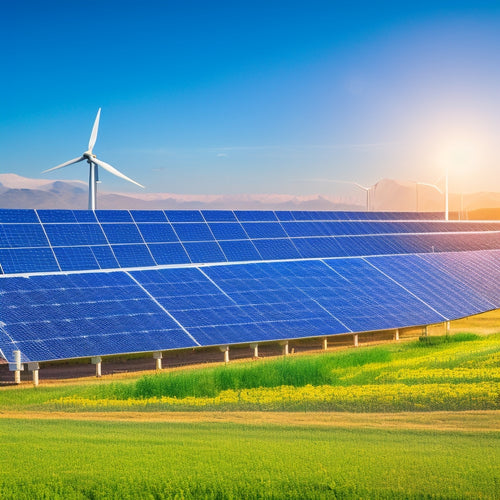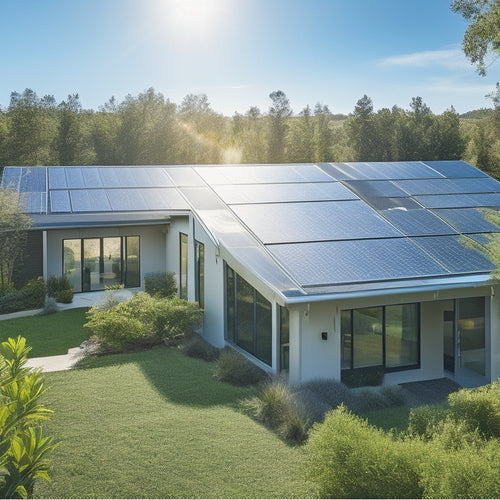
Achieving Home Energy Independence: A Step-by-Step Guide
Share
You're taking the first vital step towards achieving home energy independence by understanding that it requires an all-encompassing approach that incorporates energy-efficient habits, smart technology, and renewable energy sources. Start by analyzing your energy usage patterns to identify peak times and major energy-consuming devices, and consider investing in a home energy monitoring system to track your consumption in real-time. Then, optimize your energy efficiency by conducting energy audits, prioritizing insulation upgrades, and calculating your daily energy needs. As you progress, you'll uncover opportunities to integrate renewable energy sources, energy storage solutions, and sustainable practices that will bring you closer to achieving complete home energy independence - and there's more to investigate in your expedition towards energy self-sufficiency.
Overview
- Analyze energy usage patterns to identify peak times and major energy-consuming devices, informing energy-efficient upgrades and reduction strategies.
- Install a home energy monitoring system to track real-time energy consumption, identify inefficiencies, and optimize energy management.
- Conduct energy audits to find wasteful appliances and systems, and prioritize insulation upgrades, thermal efficiency, and resource allocation.
- Explore renewable energy sources like solar, wind, and geothermal power to reduce reliance on non-renewable sources and enhance energy independence.
- Implement energy storage solutions like batteries to manage excess renewable energy, ensure a reliable power supply, and reduce grid reliance.
Understanding Your Energy Usage
Your energy usage pattern is an essential piece of the puzzle in achieving home energy independence.
To gain a deeper understanding of your energy consumption, you need to analyze your usage patterns. This involves identifying the times of day when you use the most energy, which appliances and devices are the biggest energy hogs, and how your energy consumption changes with the seasons.
By understanding your energy usage patterns, you can pinpoint areas where you can cut back and make adjustments to reduce your reliance on the grid.
This knowledge will enable you to make informed decisions about which energy-efficient upgrades to prioritize and how to optimize your energy production and storage systems.
Home Energy Monitoring Systems
Analyzing your energy usage patterns is only half the battle - you need a way to accurately track and measure your energy consumption in real-time.
That's where home energy monitoring systems come in. These systems provide you with detailed, real-time data on your energy usage, enabling you to make informed decisions about your energy consumption.
With smart meters and advanced energy analytics, you can identify areas of inefficiency and take corrective action. You'll be able to see exactly how much energy each appliance is using, when it's being used, and where you can cut back.
This level of transparency gives you the authority to take control of your energy usage and optimize your energy independence.
Optimizing Energy Efficiency
With home energy monitoring systems in place, it's time to tackle the next crucial step: enhancing energy efficiency.
You'll want to identify areas where energy is being wasted and take corrective action. Start by conducting energy audits to pinpoint energy-hungry appliances and systems.
Next, prioritize insulation upgrades to prevent heat loss in winter and heat gain in summer. To ascertain you're enhancing your off-grid energy kit, calculate daily energy needs by considering all appliances and devices for system adequacy, and prioritize energy loads into essential, semi-essential, and non-essential for ideal resource allocation.
Sealing air leaks, adding weatherstripping, and upgrading windows can also make a significant impact.
Renewable Energy Sources
You're now ready to utilize the power of renewable energy sources to fuel your home.
You'll investigate three primary options: solar power systems that convert sunlight into electricity, wind energy benefits that tap into air currents, and geothermal heating options that capitalize on the Earth's natural heat.
When selecting a renewable energy system, consider the importance of deep cycle battery options for ideal energy storage and efficient performance.
Solar Power Systems
As a homeowner, utilizing solar power can be an important step towards energy independence, and one of the most effective ways to do so is by installing a solar power system.
This system consists of solar panels, inverters, and mounting hardware. You'll need to choose from various solar panel types, such as monocrystalline, polycrystalline, or thin-film, each with its own efficiency and cost.
When selecting a solar power system, it's vital to take into account the battery backup system, which can provide reliable energy storage and backup power during outages reliable solar battery backup systems.
Installation costs vary depending on the system size, quality, and installation company. On average, a 5-kilowatt system can cost between $15,000 and $25,000.
However, with federal and state incentives, the cost can be greatly reduced. By leveraging the power of the sun, you'll be taking a major step towards reducing your reliance on the grid and achieving energy independence.
Wind Energy Benefits
Utilizing wind energy is a crucial aspect of achieving home energy independence, and it's important to understand the benefits that come with it. By tapping into the power of wind, you can greatly reduce your reliance on non-renewable energy sources and enjoy the advantages that come with it.
| Wind Energy Advantages | Description |
|---|---|
| Renewable and Sustainable | Wind energy is a renewable resource, reducing your carbon footprint and reliance on fossil fuels. |
| Low Operating Costs | Wind energy systems have low operating costs, as there are no fuel costs and maintenance is minimal. |
| Community Wind Projects | Community wind projects enable individuals to come together and invest in wind energy, sharing the benefits and costs. |
| Energy Independence | Wind energy allows you to generate your own electricity, giving you control over your energy usage and costs. |
Geothermal Heating Options
Make use of the Earth's natural heat with geothermal energy, a reliable and efficient renewable energy source for heating your home.
Geothermal heat pumps capture the Earth's constant temperature to provide warmth during winter and cooling during summer. A typical geothermal installation consists of underground pipes filled with a heat-transfer fluid, which absorbs heat from the Earth and transfers it to your home.
Although the initial geothermal installation costs may seem high, they can be offset by significant long-term energy savings. In fact, geothermal systems can be up to 4 times more efficient than traditional HVAC systems.
Energy Storage Solutions
Your path to home energy independence relies heavily on an essential component: energy storage solutions. These solutions enable you to store excess energy generated by your renewable energy systems, ensuring a reliable and consistent power supply. With energy storage, you can manage your energy usage more efficiently, reducing your reliance on the grid.
| Battery Technology | Capacity | Cycle Life |
|---|---|---|
| Lead-Acid | 2-4 kWh | 200-300 cycles |
| Lithium-Ion | 4-12 kWh | 500-1000 cycles |
| Sodium-Ion | 1-6 kWh | 300-600 cycles |
| Flow Batteries | 10-100 kWh | 1000-2000 cycles |
| Nickel-Cadmium | 1-2 kWh | 500-1000 cycles |
Maintaining Energy Independence
Achieving energy independence is only the first step; the next essential phase is maintaining it.
To guarantee your home remains energy-independent, you'll need to implement sustainable practices and regularly assess your energy usage. Conducting regular energy audits helps identify areas for improvement, allowing you to make adjustments and optimize your energy conservation efforts.
Invest in smart technology and efficient appliances to reduce your energy consumption. Make behavioral changes, such as turning off lights and electronics when not in use, to further minimize your energy needs.
Take advantage of utility incentives and community resources to stay on track. By maintaining a vigilant approach, you'll be able to enjoy the freedom and benefits of energy independence for years to come.
Frequently Asked Questions
Can I Install Solar Panels on a Rented Property?
You'll need to review your rental agreements to see if they permit solar panel installations; if they do, you can investigate solar panel options like community solar programs or portable systems that won't alter the property.
Are Energy-Efficient Appliances Worth the Extra Cost?
You're at a crossroads, assessing the pros and cons of energy-efficient appliances, and rightly so. While they come with a higher upfront cost, you'll reap long-term benefits like significant energy savings and extended appliance longevity, ultimately giving you the freedom to break free from hefty utility bills.
How Do I Ensure Energy Independence During Power Outages?
You'll guarantee energy independence during power outages by investing in reliable backup solutions, such as battery storage systems and backup generators, which provide a seamless shift to alternative power sources when the grid fails.
Can I Sell Excess Energy Back to the Grid?
You're not just consuming energy, you're producing it! With net metering benefits and energy buyback programs, you can sell excess energy back to the grid, offsetting your bills and gaining financial freedom from the utility companies.
Are Energy Independence Systems Tax-Deductible?
You'll be pleased to know that your energy independence system investments can lead to significant tax savings, as you're likely eligible for tax credits and renewable energy incentives, potentially offsetting a substantial portion of your upfront costs.
Ready to Buy
As you stand at the threshold of energy independence, remember the wise words of Thomas Edison: "I have not failed. I've just found 10,000 ways that won't work." Your expedition may have its twists and turns, but with this guide, you've equipped yourself with the knowledge to overcome them. Now, go forth and utilize the power of the sun, the wind, and your own determination to forge a path to energy independence, where the only darkness is the one you leave behind.
Related Posts
-

The Role of Battery Monitoring Systems in Renewable Energy
Battery monitoring systems play an essential role in renewable energy by enhancing system longevity and optimizing pe...
-

Designing a Green Roof for Maximum Energy Efficiency
Designing a green roof for maximum energy efficiency involves several key strategies. Start by selecting native, drou...
-

Installing Metal Solar Roofs for Maximum Energy Efficiency
Installing metal solar roofs can drastically enhance your home's energy efficiency and durability. These roofs withst...


